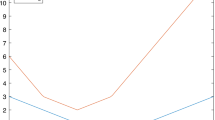Abstract
There are some optimization problems that arise when highly accurate recognition algorithms are developed. One of them is to determine an optimal feasible (consistent) subsystem in a given system of linear inequalities. The optimality is defined by a number of constraints imposed on the subsystem, which can vary. Various approaches to the solution of this problem are proposed. Solution methods based on the search through the set of nodal subsystems of the given system of linear inequalities are developed. This can be exhaustive search or partial guided search that finds an approximate solution. A drastically different approximate method based on geometric considerations is proposed.
Similar content being viewed by others
References
N. Chakravarti, “Some Results Concerning Post-Infeasibility Analysis,” J. Oper. Res. 73, 139–143 (1994).
S. N. Chernikov, Lineinye neravenstva (Nauka, Moscow, 1968) [in Russian].
M. Parker and J. Ryan, “Finding the minimum weight IIS cover of an infeasible system of linear inequalities,” Ann. Math. Artif. Intell. 17 (1–2), 107–126 (1996).
E. Amaldi and R. Hauser, “Randomized Relaxation Methods for the Maximum Feasible Subsystem Problem,” Tech. Report No. 2001-90, Politecnico di Milano, 2001.
J. W. Chinneck, “An effective polynomial-time heuristic for the minimum-cardinality IIS set-covering problem,” Ann. Math. Artif. Intell. 17 (1–2), 127–144 (1996).
M. E. Pfetsch, “The maximum feasible subsystem problem and vertex-facet incidences of polyhedra,” PhD thesis, Dep. of Mathematics, Technische Universitat Berlin, October (2002).
I. I. Eremin, Linear Optimization and Systems of Linear Inequalities (Akademiya, Moscow, 2007) [in Russian].
N. N. Katerinochkina, “Finding a maximum feasible subsystem in a system of linear inequalities” in Communications on Applied Mathematics (Vychisl. Tsentr, Ross. Akad. Nauk, Moscow, 1997) [in Russian].
N. N. Katerinochkina, “Decision methods for some discrete extreme problems in recognition theory,” Pattern Recognit. Image Anal. 18 (4), 584–587 (2008).
N. N. Katerinochkina and A. S. Shmakov, “Parallel implementation of an algorithm of finding an optimal feasible subsystem in a system of linear inequalities” in Proc. of the 13th All-Russia Conf. on Mathematical Methods in Pattern Recognition (MAKS Press, Moscow, 2007), pp. 257–261 [in Russian].
N. N. Katerinochkina, “Decision methods for some optimization problems in recognition theory,” Pattern Recognit. Image Anal. 19 (3), 441–446 (2009).
N. N. Katerinochkina, “On some optimization problem for systems of linear inequalities,” Pattern Recognit. Image Anal. 20 (4), 447–450 (2010).
Author information
Authors and Affiliations
Corresponding author
Additional information
Original Russian Text © N.N. Katerinochkina, 2015, published in Zhurnal Vychislitel’noi Matematiki i Matematicheskoi Fiziki, 2015, Vol. 55, No. 11, pp. 1959–1966.
Rights and permissions
About this article
Cite this article
Katerinochkina, N.N. Some approaches to the solution of optimization problems in supervised learning. Comput. Math. and Math. Phys. 55, 1933–1939 (2015). https://doi.org/10.1134/S0965542515110081
Received:
Published:
Issue Date:
DOI: https://doi.org/10.1134/S0965542515110081




